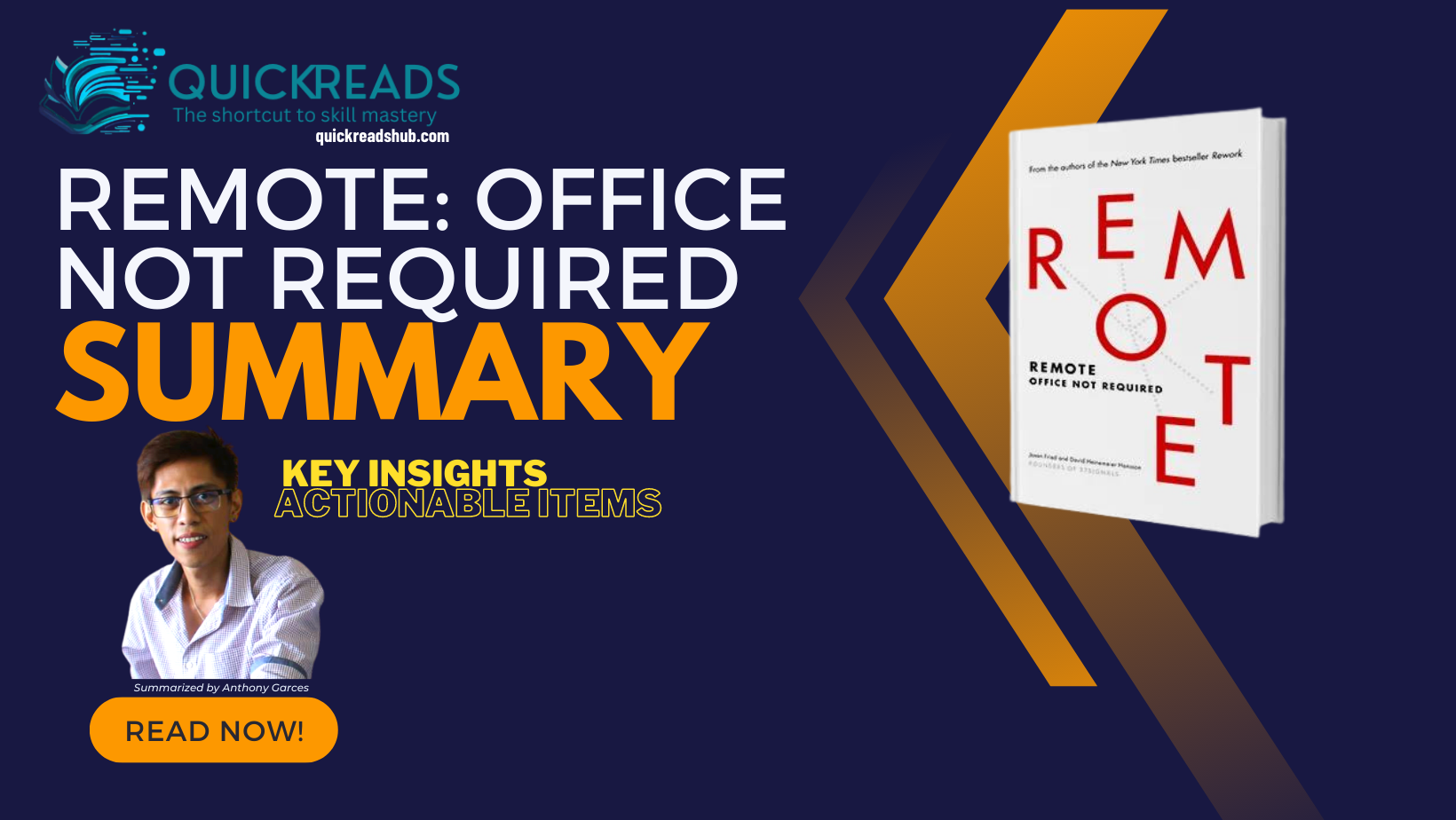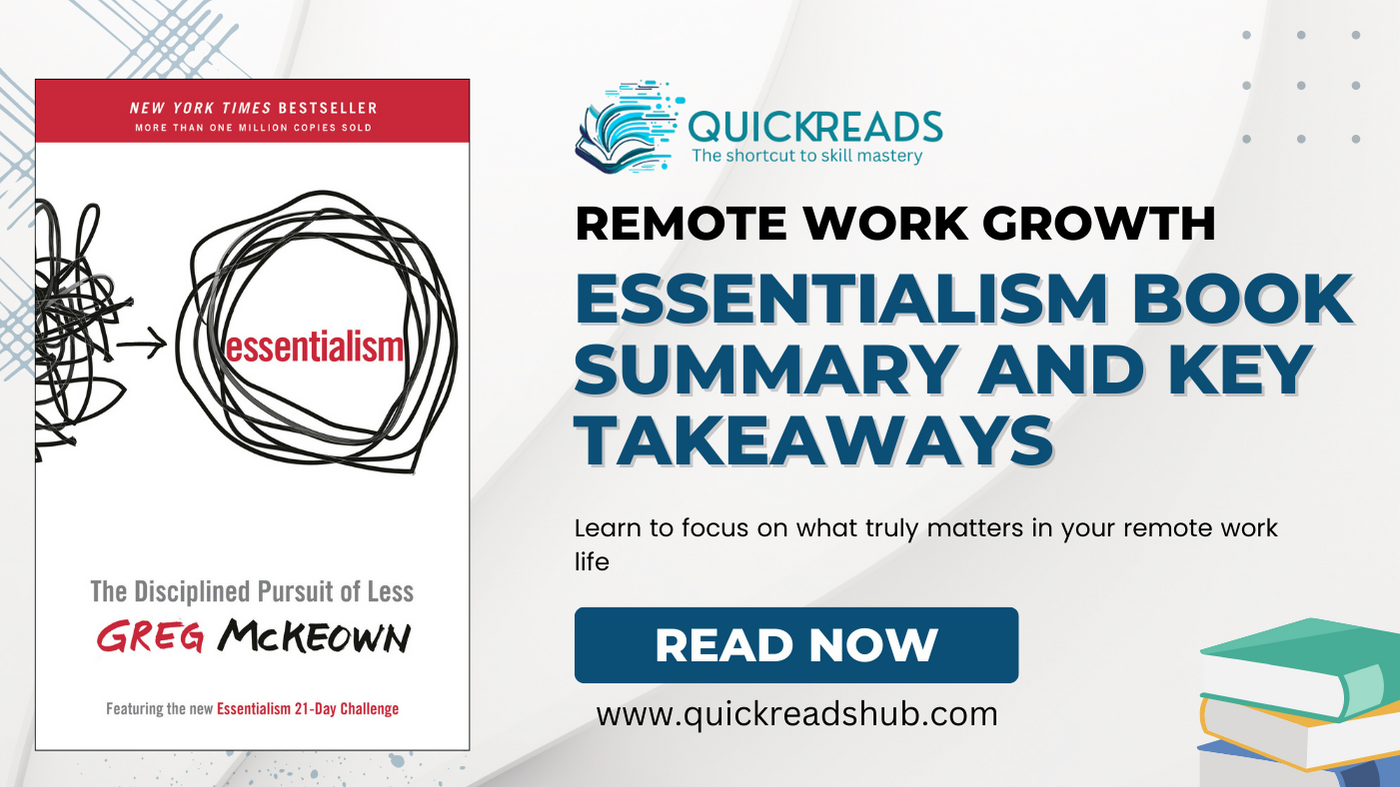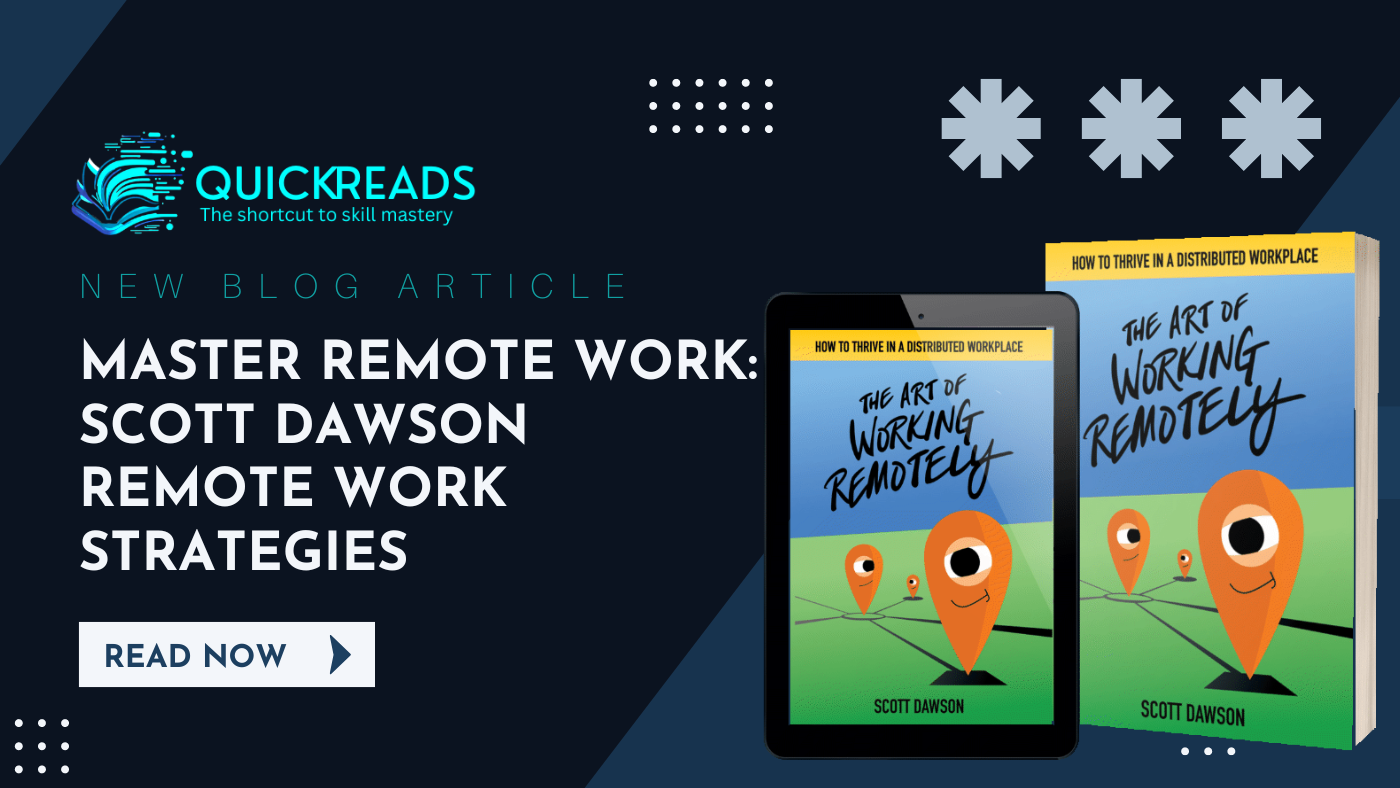I. Introduction
Can you imagine swapping the constant battle with rush hour traffic for a leisurely walk to your home workspace? This is the paradigm shift we’re exploring today in our detailed dive into “Remote: Office Not Required” by Jason Fried and David Heinemeier Hansson – a book that is breaking the chains of the traditional office setup.
Why should you care about this book and its insights? Let’s paint a picture: Imagine the aroma of your morning coffee wafting in your home office, as you settle down to work, free from the stress and distractions of a conventional workplace. Idyllic, isn’t it? This isn’t a pipe dream – it’s the reality of remote work, a burgeoning trend that is redefining the contours of the modern workforce.
In this enriching blog post, we’re set to provide a comprehensive “Remote: Office Not Required Summary,” and shed light on the countless advantages that remote work brings to the table. You’ll uncover how this fundamental shift can elevate your flexibility, turbocharge your productivity, and foster much-coveted work-life harmony.
And to those who are leading teams – we’ll also delve into how your organization can thrive by adopting a remote work culture, resulting in teams that are efficient, highly productive, and most importantly, content with their work environment. So, are you ready to dive headfirst into the future of work? Buckle up, because it’s time to begin!
II. About the Book – Remote: Office Not Required
Crafted by the brilliant minds of Jason Fried and David Heinemeier Hansson, the book is nothing short of a guide for the future of work.

Now, you might be thinking, who are these guys anyway? Well, Jason Fried is the co-founder of Basecamp, a pioneering company in the field of remote work. Along with David Heinemeier Hansson, also a co-founder of Basecamp, they have been making waves in the tech industry for over a decade. If you’ve ever used Ruby on Rails, you have David to thank for that. So, when it comes to authors who know their stuff about remote work, these two are as good as it gets.
“Remote: Office Not Required” is their insightful take on the emerging trend of remote work. What’s the big deal about this book, you ask? Well, it isn’t just a compilation of dry facts or theories. Instead, it’s filled with their real-life experiences of managing a successful remote team. They also offer practical tips and tools to help organizations adapt to this new way of working.
This book aims to equip readers, both employees, and employers, with the understanding and skills needed to navigate the often choppy waters of remote work. So, whether you’re a manager hoping to lead a distributed team, or a worker wanting to dodge that dreadful rush hour commute, this book is the compass you need.
Are you ready to unchain yourself from that office desk and embrace the freedom of remote work? Let’s explore further, shall we?
III. Remote: Office Not Required Summary
At the heart of “Remote: Office Not Required” is a simple yet revolutionary idea: work doesn’t have to be done in a traditional office setting. The book offers a refreshing take on how we perceive work, presenting remote work not just as an alternative, but as a powerful, viable path for the future. Let’s break down the key takeaways from this game-changing book.
Key Takeaways from the Book:
Part 1: The Time is Now
Fried and Hansson assert that the era of remote work is upon us. Advancements in technology have shattered geographic constraints, enabling us to work together efficiently, no matter the distance. This isn’t a glimpse into a distant future; it’s the reality of today’s work landscape.
Part 2: Dealing with Excuses
The authors tackle common reservations about remote work in this segment. Concerns such as team cohesion, employee monitoring, and potential isolation are addressed, and not just superficially – they’re systematically dismantled, with the authors making a strong case for the viability of remote work.
Part 3: How to Collaborate Remotely
Fried and Hansson transition from the “why” to the “how” of remote work. This section functions as a practical manual, offering a wealth of tools and strategies to facilitate effective remote collaboration. It’s a veritable toolkit, designed to equip you for success in the remote work realm.
Part 4: Hiring and Keeping the Best
With remote work, the pool of potential hires isn’t just the people living in your city – it’s the entire world. In this part, the authors delve into how to locate, attract, and retain top talent, irrespective of geographic limitations.
Part 5: Managing Remote Teams
Stepping into the shoes of a remote team manager may seem intimidating, but according to Fried and Hansson, it’s a rewarding journey. This chapter shares insights on how to cultivate trust, facilitate communication, and boost productivity within remote teams.
Part 6: Life as a Remote Worker
Finally, the authors give readers a glimpse into the life of a remote worker, focusing not just on work, but also on the balance between personal life and professional obligations. The elimination of daily commutes, the comfort of working in a personal space, and the opportunity to spend more time on personal interests all contribute to a heightened quality of life.
Overview of how these takeaways impact our understanding and implementation of remote work.
Throughout “Remote: Office Not Required,” the benefits of remote work are interwoven with real-world examples and practical advice, making it a comprehensive guide for anyone interested in exploring this mode of work. But this is just the beginning – as we continue to dive into the book’s insights, we’ll delve into these key takeaways more deeply, considering their implications for our understanding and implementation of remote work.
IV. Benefits of Remote Work

Diving into the benefits of remote work, we begin to realize just how much of a game-changer it can be.
Greater Flexibility
Remote work has handed back the reins of our time to us. Imagine ditching the 9-to-5 schedule and working when you are at your productive peak, whether that’s at the crack of dawn or late at night. Remember Jane, our digital marketer from Madrid? She revels in the ability to pick up her kids from school without worrying about being late for a meeting. That’s flexibility for you!
Increased Productivity
Some critics may argue, “But isn’t remote work a productivity nightmare?” On the contrary, my friend. Several studies have busted this myth. Take, for instance, a Stanford study involving call center employees, which showed a 13% performance increase by those working from home. Why? Fewer breaks and sick days, along with a quieter, more comfortable environment, might be the answer. So, if productivity is your concern, rest easy.
Better Work-Life Balance
Ah, the elusive work-life balance. Well, remote work brings this within our grasp. Imagine finishing your day’s work and immediately being able to switch to personal time. No more long commutes or office distractions. Remote work allows you to blend work and life in a way that suits you best. Sounds like a dream, right? For our software developer, Paul from New York, this dream is his everyday reality.
Reduction in Commute Stress
Say goodbye to traffic jams and crowded trains. With remote work, your longest commute is from your bedroom to your home office, maybe via the kitchen for a coffee pit-stop. Less commuting equals less stress, more time, and lower carbon emissions—a win-win situation!
Cost Savings
Remote work saves money, both for employees and employers. For employees, no commute means savings on fuel or public transportation costs. And let’s not forget the savings on work clothes and lunch expenses! For employers, it’s about reduced office space, lower utilities, and less office equipment. It’s a paradigm shift that has a direct impact on our wallets.
In sum, the benefits of remote work are vast and transformative. It’s no wonder that businesses around the world are increasingly embracing this trend.
V. How the Benefits of Remote Work are Reflected in the Book “Remote: Office Not Required“
As we delve deeper into the pages of “Remote: Office Not Required,” it becomes abundantly clear that the benefits of remote work are more than just theoretical; they’re practical, tangible, and accessible to anyone ready to embrace this new paradigm.
Greater Flexibility
The authors, Fried and Hansson, passionately discuss how remote work is a fundamental shift from rigid office hours to a more flexible, individual-centric approach. They share anecdotes from their own company, Basecamp, where employees from different time zones determine their own schedules, harnessing their most productive hours to deliver top-notch work. It’s not about being online at the same time, but about producing great work, irrespective of when or where it’s done.
Increased Productivity
“Remote: Office Not Required” directly challenges the misconception that employees need constant supervision to stay productive. The authors argue, that autonomy and trust in remote work setups can boost productivity. Remember the study mentioned earlier? Fried and Hansson back this up with their experiences, highlighting how eliminating distractions like unnecessary meetings leads to a more focused work environment.
Better Work-Life Balance
Fried and Hansson are big proponents of work-life balance. In their book, they argue that remote work blurs the lines between personal and professional life in a good way. It allows us to intertwine our work with our personal lives, rather than them being in constant battle. This not only reduces stress but also contributes to overall happiness, leading to more engaged and satisfied employees.
Reduction in Commute Stress
The book explores how commuting can often be the most stressful part of the day. Eliminating the commute, they argue, can lead to happier and more relaxed employees who can channel their energy towards productive work rather than battling rush hour traffic.
Cost Savings
The financial benefits of remote work are laid out clearly in “Remote: Office Not Required.” The authors talk about the savings on real estate and utility costs for employers and lower commuting and meal costs for employees. But they also mention the less obvious benefits, like the potential for employees to live in areas with a lower cost of living.
In essence, “Remote: Office Not Required” does more than just advocate for remote work. It provides a blueprint for how to effectively implement it, drawing upon real-world examples to illustrate the potential benefits awaiting businesses ready to break free from traditional work models.
VI. Addressing the Challenges of Remote Work

Remote work is a paradigm shift that comes with its unique set of challenges. In “Remote: Office Not Required,” Fried and Hansson don’t shy away from addressing these concerns head-on, offering practical solutions grounded in their experience with running a successful remote company.
Communication Breakdown
One common issue with remote work is communication. Without the face-to-face interactions that an office provides, miscommunications can occur. The authors counter this by advocating for clear, concise written communication. They emphasize the importance of setting expectations, providing feedback, and making use of the myriad of digital tools available to facilitate remote conversations.
Isolation and Loneliness
Working remotely can sometimes lead to feelings of isolation and loneliness. The book addresses this by promoting the creation of a strong company culture that transcends physical barriers. They suggest virtual social events, online chat channels for non-work-related discussions, and annual or biannual company retreats to foster a sense of community.
Difficulty in Supervising Employees
The book also tackles the challenge of managing remote workers and ensuring productivity. The authors argue that if an employee can only be productive in an office, under direct supervision, then perhaps they’re not the right fit for the company. They stress that the goal should be to hire self-motivated individuals who can thrive in a remote setting.
Time Zone Differences
Handling time zone differences is another challenge in a remote setting. The authors recommend asynchronous communication, where work does not have to happen at the same time for everyone, but instead, each employee works during their most productive hours. The focus should be on the work accomplished, not the hours clocked in.
Struggle to Separate Work and Personal Life
Finally, the authors recognize the struggle to separate work and personal life when your home becomes your office. They encourage setting boundaries, like dedicated workspaces at home and specified ‘quiet hours’ during which work-related communications are kept to a minimum.
By addressing these challenges in “Remote: Office Not Required,” Fried and Hansson not only provide solutions but also validate the experiences of those transitioning to remote work. They depict remote work not as a trend, but as a viable, sustainable, and beneficial mode of work for the future.
VII. Conclusion
As we wrap up our exploration, we find that “Remote: Office Not Required” by Jason Fried and David Heinemeier Hansson acts as an enlightening beacon guiding us through the intricacies of remote work. Within the Remote: Office Not Required Summary, the authors unpack the numerous advantages that come with remote work – from amplified flexibility and productivity, a refreshing work-life equilibrium, and minimized commuting stress, to potential cost savings.
Imagine being like Sarah, a software developer and avid mountain biker. She once struggled to balance her demanding office job and her passion for biking. When she transitioned into remote work, after reading this book, not only did her productivity soar, but she also found more time to enjoy her hobby and feel less stressed.
True to its practical nature, the book doesn’t skirt around the potential challenges of remote work, whether it’s the risk of communication gaps, the sensation of isolation, the difficulty in supervising employees remotely, coping with time zone disparities, or the tricky task of creating boundaries between work and personal life. Most importantly, it shares tangible and tested strategies to overcome these obstacles effectively.
This book provides a realistic yet optimistic viewpoint on remote work, acknowledging its challenges while maintaining that the rewards can significantly surpass them. It presents a compelling case that remote work is not merely a fleeting reaction to contemporary necessities, but rather a resilient, beneficial, and future-centric way of working.
As we sail through an era of digital transformation, the significance of this book and the wisdom it offers is more relevant than ever. Whether you’re an employee pondering the switch, a manager helming a remote team, or a CEO contemplating the transition for your entire organization, the insights from our Remote: Office Not Required Summary can profoundly shape your perspective and strategy.
In fact, as our perception of work is being redefined, embracing remote work might not merely be a choice—it could well be the secret key to unlocking a life brimming with flexibility, productivity, and balance. Just like Sarah, consider taking that leap of faith today and experience for yourself the rich benefits that remote work can offer.
VIII. Takeaways
As you take away the essence of our Remote: Office Not Required Summary, you’ve now begun the journey to grasp the full potential of remote work. But remember, this is just the starting line of an exciting marathon, not the finish tape. Let’s use this newfound understanding as a springboard for a shared learning expedition.
Imagine for a moment, your friend, Jake, who was always caught up in the 9 to 5 grind, constantly complaining about the commuting hassle. One day, he stumbles upon the concept of remote work and decides to give it a try. His life transforms, he’s happier, more productive, and has more time for his hobbies and loved ones. Wouldn’t you want to inspire a ‘Jake’ in your life by sharing this blog post?
We urge you to disseminate this blog post amongst your peers, friends, and anyone who could reap the benefits of our insights. By expanding the dialogue about the pros and cons of remote work, together, we can chart a course through the evolving map of the working world.
We’re particularly interested in hearing your personal narratives and experiences with remote work. Have you already embarked on this journey, or are you just on the brink, like Jake was? Are there distinctive challenges you’ve faced that we haven’t covered yet? Your unique stories and experiences enrich our communal knowledge pool. Please, leave a comment below, and let’s spark an engaging conversation.
Furthermore, if this post has whetted your appetite, we strongly suggest reading the full book, “Remote: Office Not Required.” It offers a more detailed and nuanced understanding of the remote work world, brimming with actionable advice, real-life examples, and practical tactics to aid your remote work transition.
Just like Jake didn’t venture into remote work alone, you don’t have to either. We’re here to learn, assist, and grow together. So, let’s share, comment, and continue the learning journey. The future of work is knocking at our doors, and united, we can fully harness its power.





